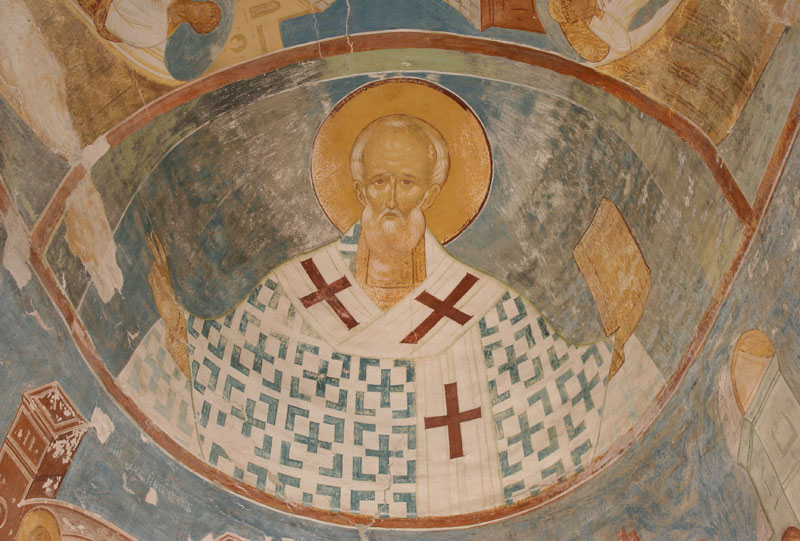December 19, 2013

St Nicholas, the patron saint of Russian merchants. Fresco by Dionisius from the Ferapontov Monastery, Russia.
Fox News's Megyn Kelly got into a bit of hot water the other day when she asserted (in what she later insisted was a light-hearted aside), that Santa Claus is a white man. This led to numerous ripostes from the usual suspects. While some of these responses were mean-spirited, others were clever.
"Santa can't just change colors," quipped Stephen Colbert. "It's not like he's magic or anything."
Ah, but that gets to the crux of things, doesn't it?
"Santa Claus" is an Anglo-Germanic rendition of "Saint Nicholas," which is fitting enough, because the original inspiration is a man named Nicholas who was a saint in the early Christian Church. He is believed to have been born in a Mediterranean village then called Patara and now known as Demre.
Nicholas' wealthy family raised him in the faith -- one of his uncles was a priest -- and when his parents died, he followed his uncle's career path while using his inheritance to help the needy. Nicholas became a bishop in the church, which had not yet undergone the split between Roman Catholicism and Eastern Orthodox.
Under the reign of Roman Emperor Diocletian, Christians were widely persecuted; Nicholas was among those imprisoned. He was not martyred, however, as were so many early saints. One aspect of his life that would lend itself so easily to myth-making was that he apparently died of old age, beloved by his fellow believers, and universally revered for his generosity.
In later years, Nicholas would be claimed as a patron saint by many people, most especially sailors, as the miracles and good deeds credited to him piled up. In one act of kindness, he threw three bags of gold through the window of a house where a poor widower lived with three daughters who needed a dowry in order to marry. It is said that the bags of gold landed in stockings hanging by the chimney. Perhaps you see where this is going...
Nicholas died December 6, in the year 343 (December 19 on the Julian calendar), and it is this anniversary that became a day of celebration, St. Nicholas Day.
In the ensuing centuries Christianity spread throughout the remnants of the Roman Empire, and by the end of the first Christian millennium Nicholas was the faith's most popular saint, celebrated -- as was Jesus -- for his many miracles and his love of children. By the year 1100,notes writer Jason Mankey, French nuns were leaving gifts in St. Nicholas' name at the homes of poor children on the night of December 5.
St. Nick wasn't done evolving, though. He'd scarcely begun. As Christianity spread northward, local peoples merged his legend with those of other sovereigns and deities. The death of Nicholas (and the birth of Christ) became infused with the Norse and Germanic celebrations of the winter solstice known as Yule.
For all we know, Nicholas of Patara was walking down the lane on foot when he anonymously tossed those bags of gold into another man's house. But the St. Nicholas of Northern Europe was now given a horse -- one previously ridden by the Norse god Odin. This steed, by the way, could land on rooftops.
As it happens, Odin also had a naughty list. Elsewhere in Scandinavia, a god named Thor seems to have added to Santa's transportation options: Thor had a cart, pulled by goats. (In Holland, where the "Sinterklaas" tradition remains strongest, he still rides a horse named Schimmel).
It is the Dutch who brought this tradition to America. On these shores, it was refined many times, first in books, later in movies, and ultimately by tens of thousands of mall Santas in identical red suits. Santa makes his first appearance in a New York newspaper in 1773, three years before Thomas Jefferson pens the Declaration of Independence.
Washington Irving, writing under the satirical pseudonym Diedrich Knickerbocker, furthers the legend. Irving's 1809 book, A History of New-York from the Beginning of the World to the End of the Dutch Dynasty, is intended as a Federalist Party send-up of Jefferson. But the satire is lost on a mass audience more enthralled by stories of a guardian saint, Nicholas, who slides down chimneys to give kids presents at Christmastime.
By 1821 an anonymous poem reaffirms the gift-giving proclivities of "Santeclaus," while replacing Odin's goats with reindeer. Two years later, Clement C. Moore's The Night Before Christmas is published. By the 1850s, America's preeminent cartoonist and illustrator, Bavarian-born Thomas Nast, is drawing on his native culture to flesh out the images of Santa that dance in our heads to this day.
"His Santa Claus wasn't a bishop," writes Jason Mankey, "but a man of the people."
"In a world that so often lacks any magic, Santa provides a doorway into a realm of imagination and wonderment," Mankey adds. "A world without Santa is a world I don't want to live in. We share so little myth these days, and what myth we do share rarely transcends religious boundaries, but Santa is different. With his origins in Greek myth, Catholic tradition, Norse paganism, and the wilds of the human imagination, he's capable of not just magically jumping down chimneys, but of jumping into the hearts of whoever will have him."
No comments:
Post a Comment